John Hurrell – 7 March, 2024
Therefore I am arguing that if Davidson is right, then Buchanan's project is naive. I say this because the objects made by the artists Posenenske and Robinson look functional and metaphorically recontextualised as channels to Gilmore's writing and its political ideational purposes, and yet if thwarted as tropes (hinted by form or names indicating purpose), their function becomes inert.
Tamaki Makaurau
Charlotte Posenenske & Peter Robinson
Priorities
Curated by Ruth Buchanan
10 February - 6 April 2024
“My ancestors threw off their language and took another… They allowed a handful of foreigners to subject them. Do you fancy I’m going to pay in my own life and person debts they made?… When the soul of a man is born in this country there are nets flung at it to hold it back from flight. You talk to me of nationality, language, religion. I shall try to fly by those nets.” (Stephen Dedalus speaking).
James Joyce, Portrait of the Artist as a Young Man, 1916, reprinted in Triad/Panther paperbacks, 1977, p.184 (Quoted and discussed by Donald Davidson in his essay, James Joyce and Humpty Dumpty.)
In this unusual pairing at Artspace Aotearoa, the German Charlotte Posenenske of the late sixties, and Peter Robinson, Ngāi Tahu Aotearoa, two different types of artist from two apparently very different cultures, here are put together to acknowledge forty-five years separation and to support the curator’s interest in debate around discursive political ‘territory’ and the writings of activist Ruth Wilson Gilmore.
In Gilmore’s published anthology of twenty essays and collegial interviews, Abolition of Geography, the title of editors’ introduction comes from James Baldwin: ‘Reports from Occupied Territory.’ Curiously, ‘territory’ here as a term in Gilmore’s texts is not metaphorical but literal, focussing on very politically-specific geographies. The back cover of her collected essays at the top states it: Freedom is not a mere principle, but a place.
In vivid contrast, it seems to me that works of Robinson and Posenenske that Buchanan has picked for this show, in the small cramped venue where they almost touch, rely on tropes that are vaguer in scope. For Robinson, I had anticipated overtly performative projects involving many participants for carrying banded rod components (such as in 2013 Auckland Triennial), to match Posenenske’s programme of audience involvement (shown in photographs)—not the selected sculptural objects loaded with metaphor that as ‘nets,’ ‘waka‘ and ‘slashed gaps‘ (filters or conveyors) matched the German ‘shutes‘, ‘flues‘, or ‘vents‘ and video of a Dutch motorway in metaphorical-type meaning. She channels tropes of conveyance where the videotape, or thin planar material that had been folded into vertical or horizontal ducts, guides interpretative possibilities around transport and destination.
In both artist cases tropes seem the order of the day, for while Robinson’s presentation of what could be military climbing nets, aggressively torn picture-planes (of penetrated walls) and ad hoc war canoes are mostly casual, quickly improvised and abandoned after use, with Posenenske the building methods are more predetermined in their organisation. Being sculpturally similar to functional office ventilation, these forms can also become a symbolic overview for the channelling and movement of military resources, being fastidiously constructed (exhibited for set time periods) with carefully aligned vectors, inwardly slanting planes, and clearly focussed objectives.
For both Posenenske and Robinson’s contributions, Buchanan’s use of word ‘territory,’ for Gilmore, is not a guiding conceptual notion that these sculptures have clung to. However if we look at the nature of metaphor and the distinction between ‘closed’ and ‘open’ then ‘territory’ is closed, for it has amongst its earlier associated meanings, limited selections that are eventually absorbed into its wider definition.
In an article on metaphor and the types of meaning it encourages when in usage, the American philosopher Donald Davidson (1917 — 2003) considers it a mistake to believe that metaphorical terms have a literal dimension and also another second figurative meaning involving paraphrasing. Davidson was a philosopher of language and semantic theorist who also wrote on rationality, objectivity, truth, history and action, developing ideas about deconstruction often inspired by Quine, Tarski and Frege, and setting them out in comparatively short, dense, tightly interconnected essays.
In a suite of related short essays (What Metaphors Mean (1978); A Nice Derangement of Epitaphs (1986); James Joyce and Humpty Dumpty (1988), Locating Literary Language (1993)): Davidson focusses on how metaphors (mainly in the first) and malapropisms (specifically in the second) are used. In metaphors the point is not what the delegated (defining) words mean. The meaning of the words doesn’t alter, in that their literal meaning doesn’t change when they become metaphors, but something is added. Its effectiveness is bound, he later decided, to intentionality—but still at the same time linked to the ‘first meaning’ or literal definitions of the expressed language. That never changes, for metaphor is not a part of speech with extraordinary or symbolic properties, but instead language that is conspicuously ordinary and prosaic, and effective only through its usage.
Thus he writes:
“No theory of metaphorical meaning or metaphorical tuth can help explain how metaphor works. Metaphor runs on the same familiar linguistic tracks that the plainest sentences do…What distinguishes metaphor is not meaning but use…And the special use to which we put language in metaphor is not—cannot be—to ‘say something’ special, no matter how indirectly. For a metaphor says only what it shows on its face—usually a patent falshood or an absurd truth. And this plain truth or falsehood needs no paraphrase—its meaning is given in the literal meaning of the words.” (1)
Therefore I am arguing that if Davidson is right, then Buchanan’s project is naive. I say this because the objects made by the artists Posenenske and Robinson look functional and metaphorically recontextualised as channels to Gilmore’s writing and its political ideational purposes, and yet if thwarted as conspicuous underpinning tropes, their function becomes inert.
Incidentally Posenenske’s rebuttal of art as a politically effective activity sixteen years before she died of cancer, raises questions about her much later involvement in this show. I’m not claiming artists can control the interpretation of their work (that is a separate issue) but if they vociferously despise their earlier activity so much so that they abandon it, you wonder if it should be showcased long after their death—if they didn’t destroy it. Or, if she chose not to, does that imply second thoughts? Or should we not care anyway?
Posenenske’s portable modules (of folded steel or cardboard) are easily recombined with other ‘family’ units in democratic processes using teams to quickly recreate new sculptural configurations when desired. So is the point of their creation that of community participation and—if desired—new compositional reorganisation that is flexible, or is it the symbolic functionality within those forms (as channelling tropes) that is the point, and not that they might enable the expression of political content in a more spontaneous but collective fashion?
When we fit the bits together, are we seeing the political efficacy of Buchanan’s show relying on the interaction between the content of her accompanying Artspace Aotearoa text, the Gilmore anthology she admires, and the Robinson and Posenenske exhibits that attempt to metaphorically link the two? Does that functional link in fact exist? Davidson enthusiasts (like perhaps the American artist, the late [at times ‘Minimalist’] Robert Morris) may not think so.
John Hurrell
(1) Donald Davidson, “What Metaphors Mean”, in The Essential Davidson, edited by Ernie Lepore and Kirk Ludwig, OUP, 2006, p.220.
Recent Comments
Ralph Paine
Vent, sieve, vortex, spiral, net, tube, tear, rent, hole, tunnel, screen, landscape, milieu, territory, line, assemblage, frame, deterritorialization/reterritorialization, cut, photograph, ...
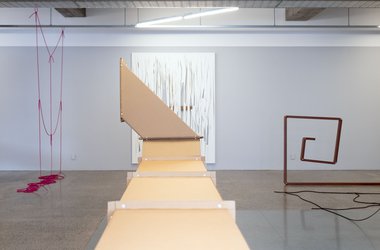
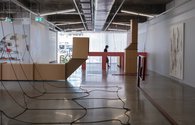


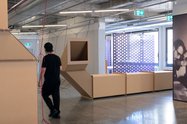
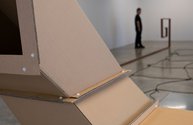
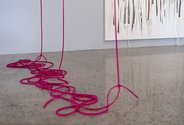

 Advertising in this column
Advertising in this column Two Rooms presents a program of residencies and projects
Two Rooms presents a program of residencies and projects



This Discussion has 1 comment.
Comment
Ralph Paine, 3:18 p.m. 9 March, 2024 #
Vent, sieve, vortex, spiral, net, tube, tear, rent, hole, tunnel, screen, landscape, milieu, territory, line, assemblage, frame, deterritorialization/reterritorialization, cut, photograph, slash, join, floor, emplacement, motorway, breach, air, colour, topology, edge, surface, worlding, door, abstract, body, wall, timing, spacing, virtual, format, tension, flue, shaft, contiguity, fold, bend, crease, nut ‘n’ bolt, curl, knot, text, window, perforate, light …
No, there is no metaphor here, only a production/proliferation/prioritisation of the literal-as-such (= matter-of-fact, plain, real, exact, bare, precise).
Hence: with 'Priorities' Buchanan is practicing a curatorial literalness, a form of anti-metaphor in which she says what she does and does what she says. Or better, that the WAY she says it is isomorphic to the way the installation is, the way its various components operate, function, interrelate, mutate, remain hidden, etc.
Consequently, this literalness takes full account of its own involvement-as-abstraction within or at the same level as the concrete processes, intensities, affects, and arrangements/rearrangements of which it writes.
None of this, however, addresses the matter-of-fact dimension of Artspace-as-organisation. This is where Ruth Wilson Gilmore’s texts seem most relevant. Not, that is, in any discussion of metaphor, but in politico-type discussions regarding art labour, the state, hierarchy, funding, freedom, etc. Published under the title ‘The Revolution Will Not Be Funded: Beyond the Non-Profit Industrial Complex’ there’s an anthology of essays—inclusive of one by RWG—which highlights Buchanan’s dilemma regarding the politics of her role as Artspace’s director. In brief: can a CNZ funded non-profit organisation operate in that place where freedom is a place?
Participate
Register to Participate.
Sign in
Sign in to an existing account.